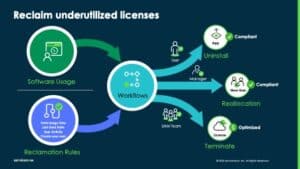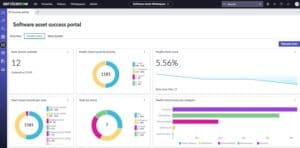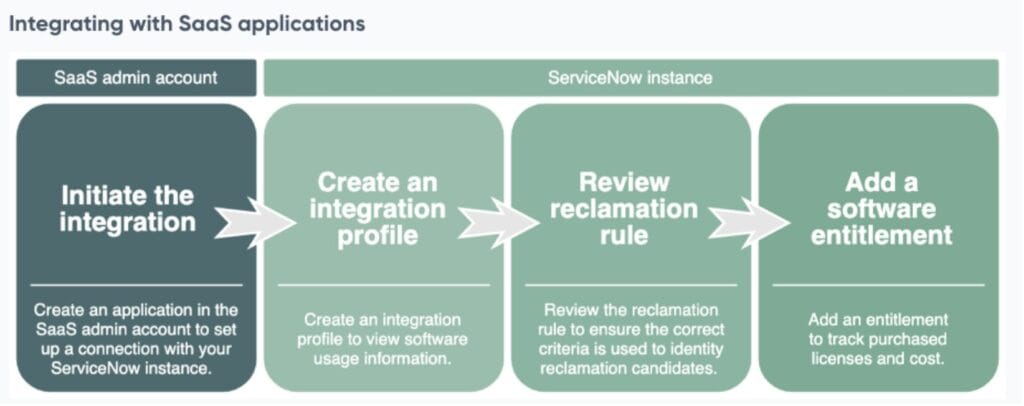Walking Phase: Cost Savings / Risk Mitigation
Make the most of your SAM Program. In this phase, you will begin to establish processes, policies, resources, and tools to execute your Software Asset Management program roadmap. You can automate the manual processes and procedures that were established during the SAM phase. Crawl. Move on to more complex licensing models found in datacenter environments, Bring Your Own License (BYOL) use cases, and additional SaaS publishers. Consider governance and cost control through software metering and recovery, identify redundant software, and adjust the software portfolio based on compliance results.
Process: Entry of new software titles into the organization
Establish a process for bringing new software titles into the organization. This process should include architectural, security, procurement, and contract reviews. Identify licensing metrics, contractual terms and conditions, installation requirements, software type (subscription or software installation), and designate who owns the product.
Steps to complete:
- Identify the stakeholders who will be involved in the new software entry process.
- Create the process and define the method for input.
- Using a Catalog item or Demand record will help with automation, routing approvals and reviews.
Datacenter/Infrastructure Environment Discovery
In the Crawl phase, we focus on software discovery in the End User Compute (EUC) estate. In the Walk phase, we turn our attention to software deployed in the data center. Software discovery in data centers requires more sophisticated tools and processes to handle virtualization, dynamic environments, and complex licensing.
It is recommended that you use ServiceNow Discovery to automatically populate your data center. Discovery uses patterns in the discovery process that you can create or customize. The base system contains a wide range of patterns that cover most industry-standard network devices and applications. The following are some of the base system patterns used by Software Asset Management:
- Microsoft SQL Server
- Microsoft Exchange Server
- Oracle Database Server
- VMware vCenter
- Citrix XenApp
- Citrix XenDesktop
You can also customize other defaults for Software Asset Management.
Additionally, ServiceNow SAM also provides specific capabilities to collect datacenter software information required by specific software publishers, including:
IBM:
You can integrate with ILMT or BigFix Inventory using version 1 or 2 of the integration APIs. The Software Asset Management application uses these APIs to retrieve data such as software installation data and peak usage data. For more information Click here.
You can track and manage IBM licenses in VMware vSphere environments and IBM LPAR infrastructures by integrating the IBM Software Publisher Management Pack with Software Asset Management providers authorized to participate in the IBM Authorized SAM Provider Program (IASP). With these integrations, you can track and manage IBM licensing directly. For more information, Click here.
Oracle:
To collect installation and usage data for Oracle products deployed in your environment, you must use a Discovery process. By verifying and enrolling ServiceNow in the Oracle Third-Party Tool Vendor (3PTV) Program, both the ServiceNow Discovery application and the Software Asset Management application are verified by the vendor to collect and report this data without the need for Oracle measurement tools. For more information on this discovery, see the Oracle Global License Advisory Services (GLAS).
SAP:
To start connecting your SAP systems to your ServiceNow instance, deploy the ABAP for SAP program.
Steps to follow:
- Identify data sources for datacenter use cases and the credentials required for all different environments.
- Work with CMDB teams to verify scanned environments and ensure relationships to multiple applications and virtual environments are populated.
Setting up direct integrations with SaaS products
Based on the broad understanding of SaaS usage gained in the Inception phase, now is the time to optimize spending on your most used and most expensive SaaS applications.
Create direct integration profiles to view software usage information and optimize inactive or underutilized licenses.
The SaaS Integration Profile pulls your company's software usage information directly from the vendor. This information includes a list of all users and identifies which ones haven't used the software recently.
See here for the current list of all pre-built SaaS integration profiles. Be sure to check this list regularly as the ServiceNow releases new integrations quarterly!
You can also build integrations for Adobe Cloud and Microsoft Office 365. For more information, see integrating with Microsoft 365 and the software editor management package for Adobe.
After following this process, you will be ready to start reclaiming unused licenses, reducing software costs for your company.
Steps to complete:
- Check out the list of supported integrations, available on the ServiceNow documentation website.
- Download the SaaS License Management app from the ServiceNow store.
- Follow the integration instructions for each SaaS application.
After integration is complete and software subscription records are created, use the pre-generated software templates to create license grants.
EUC/SaaS: Compliance Validation
The compliance validation maturity item is required to ensure that the process is in place, to verify reconciliation results, and to identify and correct any data-related issues. Reconciliation and compliance checks are critical to the SAM Program to minimize adjustment and audit costs, and to help reduce waste and software overspending.
Steps to follow:
- Validate reconciliation results in ServiceNow Software Workspace.
- Identify and correct any data-related issues. The store’s ITAM Health Check application can be used to identify missing or misconfigured data that may result in incorrect compliance results.
- Establish a communication plan to notify stakeholders of findings and/or issues that may need attention.
- The maturity item is to establish a validation process. Full compliance activities for each individual publisher/product will occur iteratively.
Create/import license grants for Datacenter software products
In the Crawl phase, we focused on creating licensing data for end-user computing software. In the Walk phase, we expanded the scope to include datacenter software.
The complexity of datacenter software licenses versus EUC software licenses varies greatly due to differences in usage environments, scope, scalability, and compliance requirements. Below is a breakdown of the key differences:
- Typically, datacenter software is licensed for large-scale, multi-tenant environments. Examples include server operating systems (e.g., Windows Server, Linux), virtualization platforms (e.g., VMware, Hyper-V), and databases (e.g., Oracle, SQL Server).
- These licenses are often designed to accommodate multiple servers, virtual machines, and data-heavy workloads.
- The software can be installed on multiple physical servers, virtual machines, or even in different geographic locations.
- Licensing models for datacenter software are often based on metrics such as processor/core count, physical/virtual machine (VM) instances, or RAM allocation. For example, database licenses can be based on the number of CPU cores in use (core-based licensing) or per server.
- Licenses can be perpetual or subscription-based and can involve more complicated enterprise agreements with volume-based discounts.
- They may also include concurrent user licensing, in which a limited number of users can access the system at the same time, regardless of how many users are registered. This type of licensing is common in engineering/design software products.
- Data center software often comes with complex support agreements involving different levels of service (e.g., 24/7 support, on-site technicians, etc.). Maintenance fees are often significant and must be renewed annually, covering upgrades, patches, and premium support.
Licensing agreements often include complex service-level agreements (SLAs) that dictate performance and availability requirements.
In short, datacenter software licenses are more complex due to their scalability, varied licensing models, and integration with infrastructure. They typically involve server-based or virtualized environments and require careful compliance monitoring. The complexity of datacenter licensing arises from its need to support critical systems, while EUC software focuses more on accessibility and ease of management.
Steps to follow:
- Gather license grant data from multiple sources.
- Create software leases using the lease import and guided lease configuration or manually create the lease in ServiceNow.
- The ITAM Health Check can also be used to verify that the grant has been configured correctly.
- Repeat this process for multiple publishers and products.
Important Note: The task of creating an accurate baseline of datacenter software allowances should not be underestimated. Working with a certified SAM partner who has specialized knowledge in this area is highly recommended to ensure the success of this initiative.
Relevant Demo and Tutorial Content:
Watch here to learn about what software grants are, the process for obtaining them, and how to generate them for on-premise and SaaS environments.
Watch here to learn the steps of creating software grants using the 'Guided Playbook Experience'.
Watch here to learn the steps for creating software entitlements manually using the standard 'Software Entitlement' form.
Watch here to learn the steps to create software grants in bulk using the “Grant Import” feature.
Create Recovery Rules for EUC and SaaS software
Software Asset Management (SAM) reclaim rules are automated processes used to identify and reclaim unused or underutilized software licenses within an organization. These rules help optimize license usage and reduce costs by ensuring that unused licenses are reclaimed and made available for other users or purposes.

How the Recovery Rules work:
SAM recovery rules define criteria for detecting software that has not been used for a specified period. For example, if a user has not opened a licensed application (on-premises or SaaS) within 90 days, that license can be flagged for recovery. To better understand this topic, we have three practical topics to consider, namely:
- Automate Notifications: Once unused software is identified, SAM can send notifications to users asking if they still need the software. If they do not, the license can be automatically reclaimed.
- Reclaim Licenses: The system can automatically reclaim unused licenses by uninstalling the software or revoking access, making those licenses available to other users. This reduces the need to purchase new licenses.
- Reallocation and Reporting: Recovered licenses can be reassigned as needed, and the process generates reports on software usage, potential savings, and compliance improvements.
Overall, SAM recovery rules help organizations control software spending, maintain license compliance, and ensure efficient use of resources.
Steps to follow:
- Ensure that usage data or last used data is available.
- Determine the process for removing the software or subscription. This will either be automated via software distribution to the customer or API calls, or it will be routed to an assignment group for manual removal of the software or subscription.Relevant Demo and Tutorial Content:
Watch here to learn about software usage data, examine the different methods for importing this data, and demonstrate how to import software usage from SCCM into ServiceNow.
Watch here to learn about Recovery Rules in ServiceNow.
Watch here to learn about Removal Candidates and Software Installation Recovery.
ITAM Health Check
Now is a good time to run a Health Check for Software Asset Management.
The Health Check app from the ServiceNow Store provides a reliable overview of Software Asset Management and makes recommendations to fix any errors that may exist.

The Health Check application can be used by multiple personas, such as implementation partners, SAM managers, and support analysts, to determine the health of their configurations.
Use the Health Check application from the ServiceNow store during deployment of your Software Asset Management application to identify errors. For example, configuration errors such as incorrect configuration of entitlements or software templates, or missing data attributes found in discovery. For details on how to run the health check, see “Perform a health check for Software Asset Management.”
The current set of checks includes options for the following settings:
- SQL Server Configuration
- SQL Server CMDB
- Windows Server CMDB
- Windows Server Configuration
- Database Server – Oracle
- Java – Oracle
- Microsoft 365
- General
After running the health check, view the results on the dashboard. Read them in the form of downloadable reports, which will provide you with recommendations for resolving the issues. For more information, see Health Check.
Steps to follow:
- Download ITAM Health Check from the store.
- Navigate to the Success Portal and select the ITAM Health Check tab.
Click “Execute Scan” and select the “Suite check” to run.
Relevant Demo and Tutorial Content:
Watch here to learn more about the health check application and understand the “suite check”, “Scan Results” and “Resolution Details”.
Data Center: Standardization
The standardization process was described in the Crawl phase with a focus on EUC. The focus of this maturity item is on software products for data centers.
Steps to follow:
- ServiceNow content data is loaded into the instance.
- The data is populated into the software installation table.
- Check the normalization data in the Normalization Dashboard and “Content Service Dashboard” and “Software Asset Workspace.
Translated by 4Matt Technology from the original The Path to Value for a SAM Program in ServiceNow.


